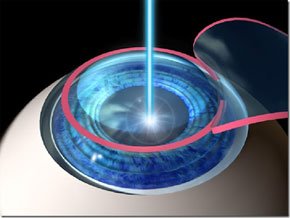If you’ve been told that you’re not a good candidate for LASIK because of thin corneas, you’re not alone—and you’re not out of options. LASEK (Laser-Assisted Sub-Epithelial Keratectomy) is a vision correction procedure that offers a safer alternative for individuals with thinner corneal tissue. In this article, we’ll explain exactly why LASEK is a better fit for thin corneas, how it compares to LASIK, and what you can expect from the procedure.
👁️ Why Corneal Thickness Matters in Laser Eye Surgery
Laser eye surgeries like LASIK and LASEK work by reshaping the cornea to correct refractive errors (myopia, hyperopia, astigmatism). But in order to safely perform this reshaping, a certain amount of corneal tissue must be preserved.
The Problem with Thin Corneas:
- LASIK requires creating a flap in the cornea, which removes a significant amount of tissue.
- If the cornea is too thin, LASIK could compromise structural integrity and increase the risk of complications like ectasia (corneal bulging).
➡️ This is where LASEK becomes the safer, smarter choice.
✅ How LASEK Works — And Why It’s Safer for Thin Corneas
Unlike LASIK, LASEK does not involve cutting a deep corneal flap. Instead, it gently loosens and lifts the thin outer layer of the cornea (epithelium), allowing the laser to reshape the surface just beneath it.
Key Advantages for Thin Corneas:
| Feature | LASIK | LASEK |
|---|---|---|
| Flap Creation | Yes (110–160 microns) | No |
| Tissue Preservation | Less | More |
| Suitability for Thin Corneas | Limited | Excellent |
| Biomechanical Strength | Reduced | Maintained |
- The epithelium is repositioned after laser reshaping, and no permanent flap is created.
- LASEK requires less corneal depth, making it ideal for patients whose corneal thickness is below the LASIK safety threshold.
⚖️ LASEK vs LASIK for Thin Corneas
Here’s a closer look at how the two procedures compare:
LASIK:
- Involves a femtosecond laser to create a corneal flap.
- Requires at least 500 microns of total corneal thickness for safety.
- Removes more tissue during reshaping, limiting use in thin corneas.
- Higher risk of flap-related complications if the cornea is borderline thin.
LASEK:
- No corneal flap is made.
- Safe for corneas as thin as 450 microns or less (depending on the degree of correction needed).
- Less invasive to corneal structure.
- Offers comparable visual outcomes to LASIK, especially for low-to-moderate prescriptions.
✅ Bottom line: LASEK offers a structurally safer approach with similar long-term results.
🔒 Better Long-Term Stability for Thin Corneas
One of the most important benefits of LASEK for patients with thin corneas is that it preserves the structural integrity of the cornea.
- Since there’s no flap and less tissue is removed, the cornea remains stronger.
- This reduces the risk of corneal ectasia, a rare but serious complication associated with LASIK in thin corneas.
- LASEK is often the recommended option by refractive surgeons when corneal measurements fall below LASIK safety limits.
🧪 Safe Technology with Customization Options
Modern LASEK procedures can be customized using wavefront-guided or topography-guided lasers, which:
- Improve visual quality, especially in low-light settings
- Reduce risk of halos and glare
- Deliver precise, patient-specific results
These technologies help optimize outcomes even in anatomically challenging eyes like those with thinner or irregular corneas.
🕒 What to Expect from LASEK Recovery (vs LASIK)
Patients with thin corneas should be aware that LASEK comes with a slightly longer recovery period compared to LASIK.
LASEK Recovery Timeline:
- Days 1–3: Eye discomfort, tearing, blurred vision
- Days 4–7: Epithelial healing, clearer vision begins
- Weeks 2–6: Gradual vision improvement
- Month 3+: Final visual results stabilize
While recovery is slower, most patients achieve 20/20 or better vision over time—without compromising corneal health.
👩⚕️ Who Is an Ideal Candidate for LASEK?
You may be a good candidate for LASEK if you:
- Have thin or borderline corneal thickness
- Were disqualified from LASIK due to structural concerns
- Have mild to moderate refractive errors
- Lead an active lifestyle and want to avoid flap-related risks
Always consult with a board-certified ophthalmologist to confirm your candidacy.
📊 Summary: Why LASEK Is Safer for Thin Corneas
| Benefit | Why It Matters |
|---|---|
| No corneal flap | Avoids weakening the eye’s structure |
| Less tissue removal | Safer for thinner corneas |
| Reduced risk of ectasia | Maintains long-term corneal strength |
| Better suited for active patients | Lower risk of injury-related flap displacement |
| Comparable outcomes to LASIK | Without the same structural demands |
👁️ Final Thoughts
LASEK for thin corneas is not only possible—it’s often the preferred and safest option. If you’ve been told that your corneas are too thin for LASIK, don’t give up on clearer vision. With today’s technology, LASEK provides excellent results with a strong safety profile, especially for patients with anatomical challenges.
📅 Ready to Find Out If LASEK Is Right for You?
Book a comprehensive eye exam with a refractive surgery specialist to:
- Measure your corneal thickness
- Evaluate your candidacy
- Compare your surgical options in detail
Your path to clear vision may still be just one procedure away.




